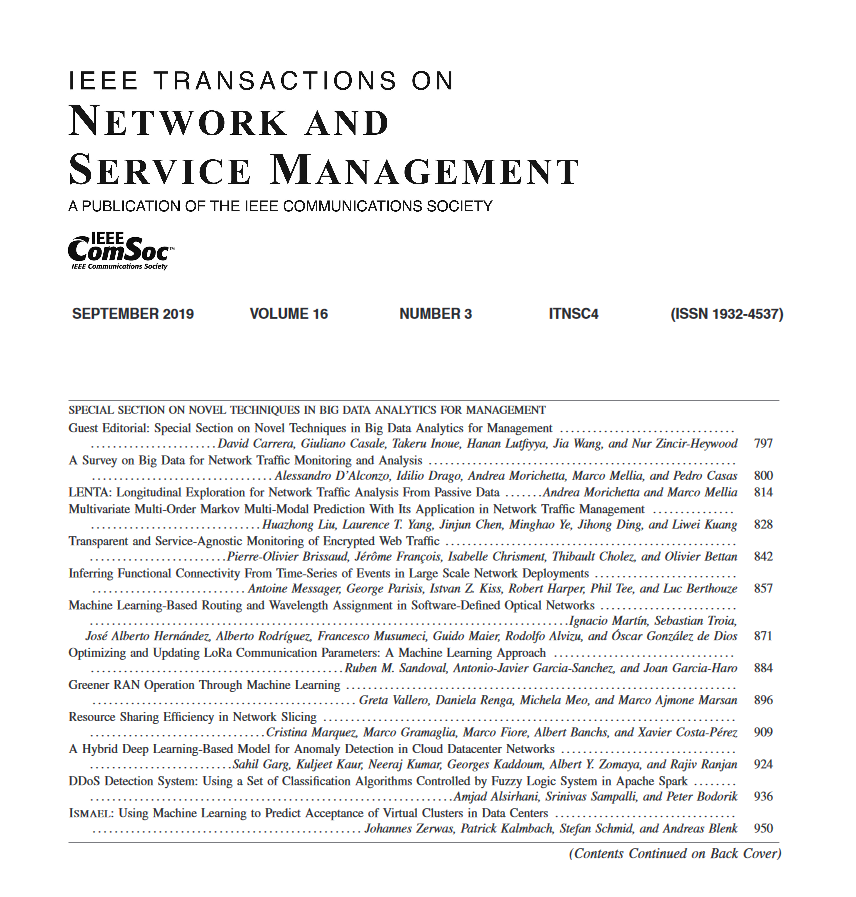移动边缘计算系统中可解释和节能的选择性集成学习
IF 5.4
2区 计算机科学
Q1 COMPUTER SCIENCE, INFORMATION SYSTEMS
IEEE Transactions on Network and Service Management
Pub Date : 2025-02-07
DOI:10.1109/TNSM.2025.3539830
引用次数: 0
摘要
可解释集成学习将可解释人工智能(Explainable artificial intelligence, XAI)和集成学习(ensemblelearning, EL)相结合,解决了EL的闭箱问题,为模型中的决策过程提供了清晰透明的解释。作为一种分布式机器学习架构,EL在边缘节点部署用本地数据训练的基础学习器,对目标任务进行推理,然后将参与的基础学习器的推理结果结合起来。然而,将所有的基础学习器都选择到EL中可能会浪费更多的计算资源,并且无法获得更好的性能。为了解决这一问题,我们提出了基于XAI的置信水平(ConfLevel)的定义,并验证了其作为选择基础学习者的度量的有效性。然后,我们采用考虑高ConfLevel和低计算能力的联合优化模型来确定选择性集成学习(SEL)的参与基础学习器。针对该问题的非凸性和组合性,提出了一种基于Benders分解的节点选择和功率控制算法(BD-NSPC),以有效地获得全局最优解。此外,仿真结果表明,与其他SEL算法相比,BD-NSPC平均每个EN消耗的能量减少了30%左右,精度提高了1-2%。此外,与联邦学习(FL)框架相比,BD-NSPC减少了约25%的能耗和约28%的延迟,在边缘计算系统中达到了相当的精度。本文章由计算机程序翻译,如有差异,请以英文原文为准。
Explainable and Energy-Efficient Selective Ensemble Learning in Mobile Edge Computing Systems
Explainable ensemble learning combines explainable artificial intelligence (XAI) and ensemble learning (EL) to solve the closed-box problem of EL and provide a clear and transparent explanation of the decision-making process in the model. As a distributed machine learning architecture, EL deploys base learners trained with local data at edge node and infers on target tasks, then combines the inference results of the participating base learners. However, selecting all base learners into EL may result in wasting more computing resources and not obtain better performance. To address this issue, we put forward the definition of confidence level (ConfLevel) on the basis of XAI and verify its effectiveness as the metric of selecting the base learner. Then, we take the joint optimization model of considering high ConfLevel and low computing power to determine the participating base learners for selective ensemble learning (SEL). Due to the non-convex and combinatorial nature of the problem, we propose a node selection and power control algorithm on the premise of Benders’ Decomposition (referred to BD-NSPC) to obtain the global optimal solution efficiently. In addition, simulation results show that BD-NSPC consumes about 30% less energy per EN on average and improves accuracy by 1-2% compared to other SEL algorithms. Besides, compared with federated learning (FL) framework, BD-NSPC reduces the energy consumption by about 25% and the latency by about 28%, achieving comparable accuracy in the edge computing system.
求助全文
通过发布文献求助,成功后即可免费获取论文全文。
去求助
来源期刊

IEEE Transactions on Network and Service Management
Computer Science-Computer Networks and Communications
CiteScore
9.30
自引率
15.10%
发文量
325
期刊介绍:
IEEE Transactions on Network and Service Management will publish (online only) peerreviewed archival quality papers that advance the state-of-the-art and practical applications of network and service management. Theoretical research contributions (presenting new concepts and techniques) and applied contributions (reporting on experiences and experiments with actual systems) will be encouraged. These transactions will focus on the key technical issues related to: Management Models, Architectures and Frameworks; Service Provisioning, Reliability and Quality Assurance; Management Functions; Enabling Technologies; Information and Communication Models; Policies; Applications and Case Studies; Emerging Technologies and Standards.
 求助内容:
求助内容: 应助结果提醒方式:
应助结果提醒方式:


